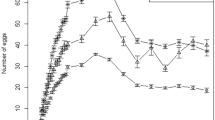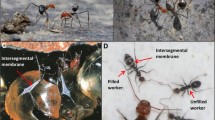Summary
The Neotropical termiteNasutitermes corniger is facultatively polygynous. In areas of young second growth in the Republic of Panamá, polygynous colonies were found commonly. Of 35 nests collected with at least one queen, 12 colonies had from 2–22 primary (first-form) queens. All females were physogastric, fully pigmented, functional egg layers. Polygynous nests had one royal cell, sometimes with multiple chambers. The queens showed no aggression toward one another under laboratory conditions. All queens within an association were of approximately the same size and weight.
It appears that polygynous colonies can be formed through budding of a parent nest and queening by several sibs from the parental colony (multiple adultoid reproductives). Formation may also be possible by cooperative co-founding of a nest by sibling queens without workers. Replacement of the original queen by more than one daughter may occur inN. corniger, but it is unlikely to be the sole method of generating polygyny in this species.
Polygynous nests may grow faster, have a higher probability of survival, and a lower age of first reproduction than monogynous neighbors. I therefore predict that polygyny will prove most common in habitats where the probability of survival is low and rapid colony growth is advantageous.
Zusammenfassung
Die Neotropische TermiteNasutitermes corniger ist fakultativ polygyn. In Gebieten jungen Sekundär Waldes der früheren Kanalzone, Panama, wurden häufig polygyne Kolonien gefunden. Von 35 Nestern die zumindest eine Königen enthielten, hatten 12 Kolonien zwischen 2–22 Primär-Königinne. Alle Weibchen dieser vielfachen Vergesellschaftung waren physogastrische, voll pigmentiert und funktionelle Eierlegerinnen. Die polygynen Nester hatten eine Königinnen-Zelle mit manchmal mehreren Kammern. Unter Laborbedingungen verhielten sich die Königinnen nicht aggressiv untereinander. Alle Königinnen in einer Vergesellschaftung hatten ungefähr die gleiche Größe und Gewicht.
Es scheint, daß polygyne Kolonien durch Abspaltung des Elternnestes entstehen, und daß die vielfachen Königinnen im neuen Nest Geschwister sind. Möglicherweise können polygyne Kolonien auch durch kooperative Nestgründung zustande kommen. Die ursprüngliche Königin inN. corniger Kolonien, könnte auch durch mehrere Töchter ersetzt werden, doch ist es unwahrscheinlich, daß dies die einzige Methode ist wie es zur Polygynie bei dieser Art kommt.
Polygyne Nester wachsen wahrscheinlich schneller, haben eine größere Uberlebenschance und reproduzieren schneller als monogyne Nachbarn. Es wird angenommen, dass Polygynie besonders häufig in den Habitaten vorkommt, in denen die Uberlebenschance gering ist und wo ein schnelles Wachstum der Kolonie von Vorteil ist.
Similar content being viewed by others
References
Andrews E.A., 1911. — Observations on termites in Jamaica.J. Anim. Beh., 1, 193–228.
Baroni-Urbani C., 1968. — Domination et monogynie fonctionnelle dans une société digynique deMyrmecina graminicola Latr.Ins. Soc., 15, 407–411.
Batra S., 1964. — Behavior of the social bee,Lasioglossum zephyrum, within the nest (Hymenoptera: Halictidæ).Ins. Soc., 11, 159–185.
Becker G., 1961. — Beobachtungen und Versuche über den Beginn der Kolonie-Entwicklung vonNasutitermes ephrates Holmgren (Isoptera).Z. Angew. Ent., 49, 78–94.
Bequaert J., 1921. — Insects as food. How they have augmented the food supply of mankind in early and recent times.Nat. Hist., 21, 191–200.
Coaton W.G.H., 1949. — Queen removal in termite control.Farming in South Africa, 14, 335–338.
Cole L., 1954. — The population consequences of life history phenomena.Q. Rev. Biol., 29, 103–137.
Dietz H.F., Snyder T.E., 1923. — Biological notes on the termites of the Canal Zone and adjoining parts of the Republic of Panama.U. S. Dept. of Agric. J. Agric. Res., 26, 279–302.
Dropkin V.H., 1946. — The use of mixed colonies of termites in the study of host-symbiont relations.J. Parasitol., 32, 247–251.
Dudley P.H., Beaumont J., 1889a. — The termites or so-called “white ants” of the Isthmus of Panama.J. New York Microscop. Soc., 5, 56–70; 111–112
Dudley P.H., Beaumont J., 1889b. — Observations on the termites, or white-ants of the Isthmus of Panama.Trans. New York Acad. Sci., 1, 85–114.
Dudley P.H., Beaumont J., 1890. — Termites of the Isthmus of Panama. Part II.Trans. New York Acad. Sci., 9, 157–180.
Harms J.W., 1927. — Koloniegründung beiMacrotermes gilvus Hag.Zool. Anz., 74, 221–236.
Hill G.F., 1942. —Termites (Isoptera) from the Australian Region. Council for Scientific and Industrial Research, Commonwealth of Australia, 479 p.
Hölldobler B., Wilson E.O., 1977. — The number of queens: An important trait in ant evolution.Naturwissenschaften, 64, 8–15.
Holmgren N., 1913. — Termites from British India (near Bombay, in Gujerat and Bangalore), collected by Dr. J. Assmuth, S.J..J. Bombay Nat. Hist. Soc., 22, 109–110.
Kaiser P., 1956. — Die Homonalorgane der Termiten mit der Enstehung ihrer Kasten.Mitt. Hamburgischen Zool. Mus. Inst., 54, 129–178.
Mathews A.G.A., 1977. —Studies on Termites from the Mato Grosso State, Brazil. Academia Brazileira de Ciencias, Rio de Janeiro, Brazil, 267 p.
Mathur R.N., Chhotani O.B., 1960. — Three queens in mounds ofOdontotermes wallonensis (Wassmann) (Termitidæ, Isoptera).Indian Forester, 86, 623–624.
Miller E.M., 1969. — Caste differentiation in the lower termites. In Krishna K., Weenser F.M. (eds.),Biology of Termites, I, p. 283–310. Academic Press, New York, 598 p.
Mukerji D., Raychauduri S., 1942. — Structure, function, and origin of the exudate organs in the abdomen of the physogastric queen of the termiteTermes redemanni Wasmann.Indian J. Ent. New Delhi, 4, 173–199.
Noirot C., 1956. — Les sexués de remplacement chez les Termites supérieurs (Termitidæ).Ins. Soc., 3, 145–158.
Noirot C., 1969. — Formation of castes in higher termites. In Krishna K., Weesner F.M. (eds.),Biology of Termites, I, p. 311–350. Academic Press, New York, 598 p.
Nutting W.L., 1969. — Flight, and colony foundation. In Krishna K., Weesner, F.M. (eds.),Biology of Termites, I, p. 233–282. Academic Press, New York, 598 p.
Nutting W.L., 1970. — Composition and size of some termite colonies in Arizona and Mexico.Ann. Ent. Soc. Am., 63, 1105–1110.
Oster G.F., Wilson E.O., 1978. —Caste and Ecology in the Social Insects. Princeton University Press, Princeton, N. J., 351 p.
Ridley H.N., 1910. — A termite's, nest with eight queens.J. Straits Branch Roy. Asiatic Soc. Singapore, 54, 157.
Roonwal M.L., Chhotani O.B., 1962. — Termite “Odontotermes obesus (Rambur)”: royal chamber with four queens and two kings.J. Bombay Nat. Hist. Soc., 59, 975–976.
Roonwal M.L., Gupta S.D., 1952. — An unusual royal chamber with two kings and two queens in the Indian mound-building termite,Odontotermes obesus (Rambur) (Isoptera: Family Termitidæ).J. Bombay Nat. Hist. Soc., 51, 293–294.
Roy-Noel, J., 1974. — Contribution à la connaissance des reproducteurs de remplacement chez les Termites supérieurs: observations surBellicositermes natalensis (Macrotermitinæ).C. R. Acad. Sci., 278(D), 481–482.
Silvestri F., 1914–1915. — Contribuzione alla conoscenza dei Termitidi e Termitofil dell' Africa occidentale. I. Termitid.Boll. Lab. Zool. Gen. Agr. Portici, 9, 1–146.
Skaife S.H., 1954a. — The black-mound termite of the Cape,Amitermes atlanticus Fuller.Trans. Roy. Soc. South Africa, 34, 251–271.
Skaife S.H., 1954b. — Caste differentiation among termites.Trans. Roy. Soc. South Africa, 34, 345–353.
Skaife S.H., 1955. —Dwellers in Darkness. Longmans, Green & Co., Ltd., London, 134 p.
Stuart A., 1969. — Social behavior and communication. In Krishna K., Weesner F.M. (eds.),Biology of Termites, I, p. 193–232. Academic Press, New York, 598 p.
Sturtevant A.H., 1938. — Essays on evolution, II: On the effects of selection on social insects.Q. Rev. Biol., 13, 74–76.
West-Eberhard M.J., 1967. — Foundress associations in polistine wasps: dominance hierarchies and the evolution of social behavior.Science, 157, 1584–1585.
West-Eberhard M.J., 1978. — Polygyny and the evolution of social behavior in wasps.J. Kansas Ent. Soc., 51, 832–856.
Weyer F., 1930a. — Uber Ersatzgeschlechtstiere bei Termiten.Z. Morph. Okol. Tiere, 19, 364–380.
Weyer F., 1930b. — Beobachtung über die Enstehung neuer Kolonien bei tropischen Termiten.Zool. Jahrb. (Syst.), 60, 327–380.
Wilson E.O., 1971. —The Insect Societies. Belknap Press of Harvard University Press, Cambridge, Massachusetts, 548 p.
Author information
Authors and Affiliations
Rights and permissions
About this article
Cite this article
Thorne, B.L. Polygyny in termites: Multiple primary queens in colonies ofNasutitermes corniger (Motschuls) (Isoptera: Termitidae). Ins. Soc 29, 102–117 (1982). https://doi.org/10.1007/BF02224531
Received:
Accepted:
Issue Date:
DOI: https://doi.org/10.1007/BF02224531




